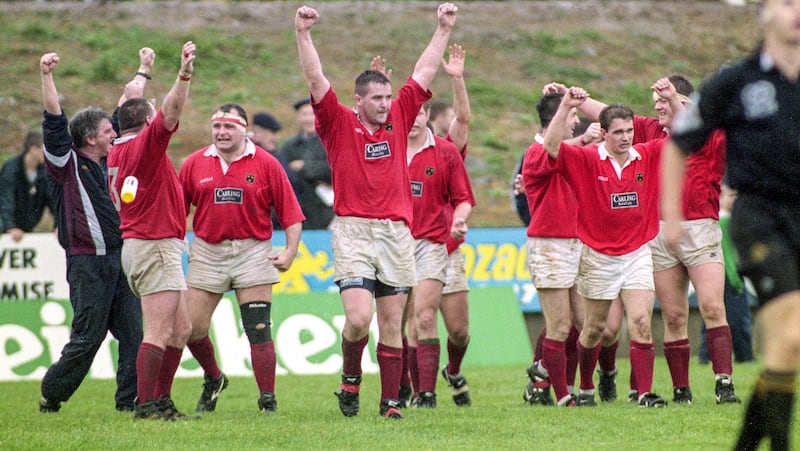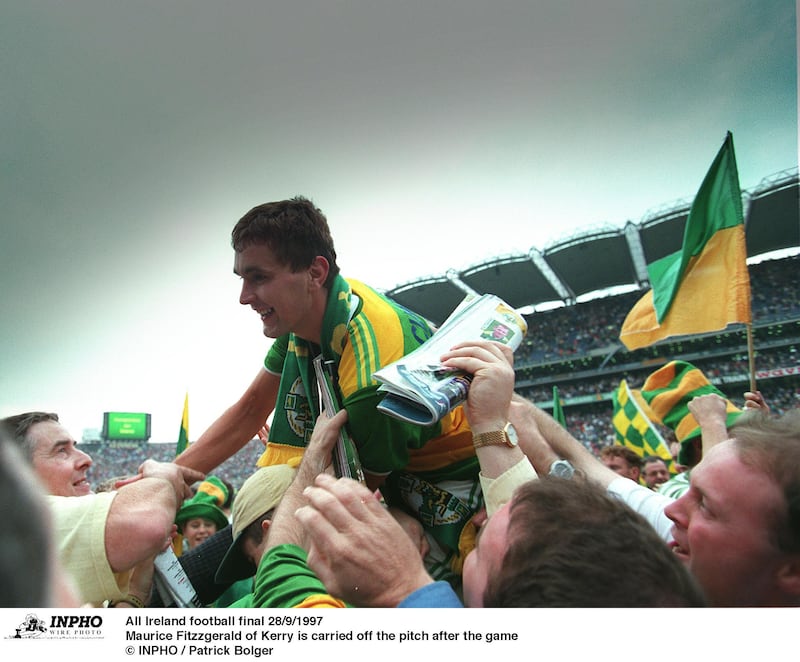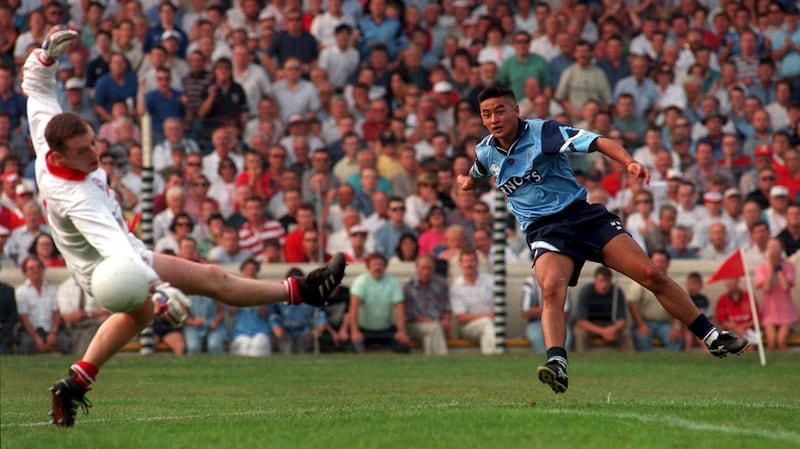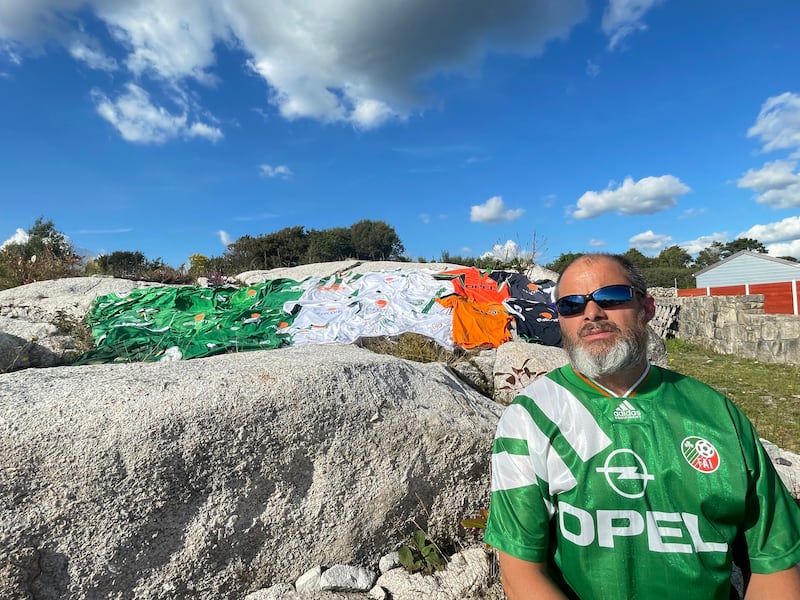Hundreds of mini sports memorabilia museums are being lovingly created and curated in bedrooms and garages across Ireland. Most received almost no visitors over the festive period, but that doesn’t matter, the joy of the collection sustains the owner above all else. There are men and women who see beauty in a faded polyester soccer jersey from the League of Ireland or an antiquated heavy cotton rugby jersey from the pre-professional era. They are the Irish collectors of sports memorabilia that was once a niche interest but is slowly going mainstream.
Dubliner Barry Rojack has been conscientiously collecting sporting memorabilia since his early childhood. Over 30 years he has created one of the most impressive collections in Ireland, spanning sports and decades. Everything is meticulously catalogued, a fact that led Rojack to set up the Irish Sports Museum with the ambition to display his historic memorabilia to the public. Rojack believes that the love of sporting collectibles often comes down to association with our happiest memories.
“I think in all types of collecting, and definitely for sporting pieces, there’s a twenty-year rule. People tend to be nostalgic about two decades ago. It’s always an interesting time of your life when you look back, it’s very different, but it’s also not that far away. There are some great memories, and you tend to filter out the noise and the stress. We look back to those sporting moments from then fondly.
“Twenty years in general is also about the length of time someone will hold on to something until it’s ready to be moved on. In 30 years of collecting I’ve seen this every single year, stuff will come up from twenty years ago. There’s this beautiful corresponding period when people are dying to get rid of stuff and also people are dying to buy it.”
There is little that Rojack doesn’t know about Irish sport. He volunteers as chairman of Cabinteely GAA club and is a passionate soccer fan. His collection started with soccer after being gifted a match-worn Everton jersey at the age of eight. By the early 2000s he had also moved into rugby, swept up with the success of the Irish provinces in Europe and the national team.
“There was a real boom in Leinster, Ireland, Munster, and even Ulster in the late 1990s and the 2000s through the Heineken Cup successes. The jerseys were becoming a lot more available. Once I got into rugby collecting, the community really stayed the same. There weren’t really sharks in the same way there might be in football. Rugby tends to be people who really love the history of the game. Rugby by its nature tends to be very much about camaraderie, and it reaches across borders. It’s not just about winning, it’s about friendships. There are people I have known from collecting in rugby for over 20 years.

“A lot of rugby collectors will go to other countries to visit friends and see their collections. For instance, I’ve visited people to see their collections in South Africa and New Zealand. The wives are also happy to see that their husbands aren’t the only crazy ones with this passion. I’ve met some great friends from all over the world and it’s a different dynamic.
“There’s also a story to rugby jerseys. For instance, South Africans and New Zealander players would never ever swap their jerseys unless they felt the opposition deserved it, so you knew the jersey had been in a battle. The jersey would have a lot more cachet. The jersey really means something.”
Adam Moynihan’s main job is as the sports editor of the Killarney Advertiser but by night he set up Vintage GAA, an online business where GAA fans from all over the world can purchase some of the most coveted replica jerseys in Irish sport. Moynihan is a keen Kerry fan and, alongside his burgeoning collection of soccer jerseys, he was always looking for vintage O’Neills jerseys from the Kingdom. He never had a problem sourcing obscure Italian or Spanish soccer jerseys, but could never find a central spot for retro GAA jerseys. The pandemic gave him the time to think about this gap in the market for Irish collectors.
“I’ve been blown away by the response to Vintage GAA to be honest. The community is still building and when I started I was worried if others would be interested. Would there be a market for selling these GAA jerseys? Straight away the feedback was really positive, people saying it’s about time that there was something for GAA jerseys. People are really interested in the stories behind the jerseys and there’s this black hole where people don’t know how GAA jerseys were made and the history behind them.
“It can be a nostalgia thing, it’s like listening to music or movies, and it brings you back to a certain time in your life. When you’re looking at a jersey in your closet or your wall, it has the same effect. A lot of people associate jerseys with All-Irelands. I know for me the 1997 All-Ireland jersey was my first All-Ireland as a Kerry supporter so it means something.

“There’s a collectable factor, some people are building a collection, and they are thinking that it will appreciate in value. But there’s been a shift, where it’s becoming a fashion element, it was once seen as uncivilised to wear a jersey unless you were going to a game. We’re seeing that in soccer, the jerseys are marketed as streetwear, not just for wearing on to the pitch. When I was setting up Vintage GAA, I saw the way soccer was going – PSG are collaborating with top brands, and other clubs with fashion brands –, why can’t it be a Kerry jersey?”
Moynihan fields enquiries from all over the world from GAA collectors, including Australia and the United States of America. The most coveted and requested jersey by far is the 1998 Adidas Kerry jersey, followed by the 1995 Dublin jersey and Cork’s 1994 and 1995 Barry’s Tea jerseys. Moynihan has enjoyed meeting people from all over the world and hearing their passion for Gaelic games.

“One of my favourite parts of this whole Vintage GAA experience has been speaking to people from everywhere in the world about why they like the jerseys. There are all sorts of stories about how much a jersey means to someone. I sell a lot of jerseys to second or third-generation Americans, whose parents, say, could be from somewhere in Mayo and they really want a jersey. That Mayo jersey might be in someone’s attic, and then it brings someone so much joy.
“GAA is obviously so linked to culture and history in this country. When I open a match-worn jersey, it’s honestly like holding a piece of GAA history and culture that we all share together. Without wanting to overstate it, it’s a very powerful thing to hold that in your hands.”
Paul Behan was working as a successful salesman in Galway for over a decade when he decided four years ago that he wanted to sell something that he was actually passionate about. He was a committed collector of replica soccer jerseys from all over the world and knew that he wasn’t alone. He created Football Kitbox, the first subscription service for replica kits. People pay a fee and are sent a box of different football kits depending on their specific preferences.

In the early days of the pandemic, with little live sport to watch, Behan found that the desire to collect football replicas grew hugely. People needed a small piece of joy, and his boxes often fitted the bill. A football shirt could almost instantly bring them back to a happier time in their lives.
“I’d been doing it for two years, and then in the first lockdown, it went crazy. I’m not entirely sure why. Maybe it was a bit of positive news. There was a community and people were showing what they were wearing every day. There weren’t the same rules as to what you were wearing every day. It was a connection people were making and it was a positive thing in such a negative time in the world.
“So many of us moved our lives online and we created a beautiful community at the start. A lot of nerds and anoraks in their rooms were able to chat with other like-minded souls. It grew and evolved, the same thing anything does.
“I think nostalgia is a powerful motivator. If the team win a league or a trophy in a specific year, fans will gravitate towards that shirt as it will remind them of the good times. Another big motivation is the style and aesthetics of the 90s, as many of the people buying the shirts were kids then. You can see the revival of fashion from the 90s even now on the street. So many of us would have seen these shirts on Sky as a kid, with all the razzmatazz of Premier League after the muddy pitches of Division 1. Irish people loved it and those memories are still so strong.”
Nostalgia is not just a powerful motivator for Premier League jerseys for the Irish collector, Behan has noticed a strong pull to vintage League of Ireland jerseys. One of the most coveted replica football jerseys is the 1989/1992 Cork City Adidas jersey sponsored by Guinness. It can easily command a fee of €500 on online auctions. The demand is driven not only by the iconic design of the jersey but also by the relative paucity of them.
“They didn’t make many replicas in the 90s in Ireland and it’s very hard to get them. There are not many of them out there, just like the Cork Guinness jersey. If you try to find a Dundalk 80s or 90s jersey, you’d do very well to get one. Irish club jerseys are selling all over the world now and not just the vintage ones. The new home Galway jersey by O’Neills is their best-selling jersey ever and it’s spectacular, with the Tribesmen design. That jersey transcends borders, it’s selling all over the world.
“People don’t just want to buy a jersey for the looks, they are interested in the story behind the club. You take a club like Bohemians who really have worked on their community ethos, and then they create really classy jersey. Clubs like Dundalk and Waterford are also making great new jerseys with Umbro. They’re tapping into the appetite from across the world and creating new fans.”
In July, Behan hosted Kit Con in Dundalk for the first time, an annual event for football shirt collectors from across Ireland. People showcased their collections, and Behan invited speakers on particular topics. The event was packed with collectors who were able to swap notes on obscure jerseys, most of which had been carefully folded in their closets.
“We had our first ever event of its kind and it seemed to go really well. The collectors just loved the fact that people were interested, [the shirts] spend their whole life hiding in the wardrobe or the attic. [Collectors] are used to people rolling their eyes, but when you’re in a conference room, you’re able to talk and showcase their displays and have people to talk about it. You just walk around and see these jerseys that are really like pieces of art. For a brief moment, people could find their tribe, and they could feel normal.”
Beauty is always in the eye of the beholder for the sports memorabilia collector. Pieces of lank polyester that were once ignored at the back of Irish charity shops are now prized Christmas gifts. Slowly but surely the history of Ireland’s greatest sporting moments is being brought back to life through collections across the country.



















